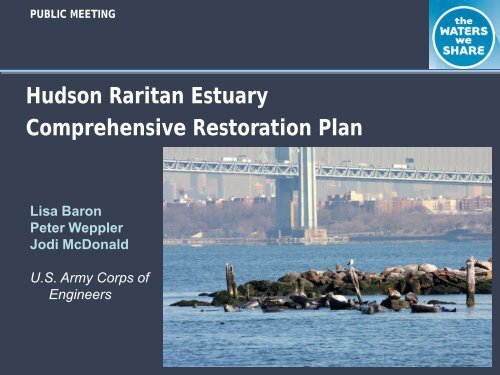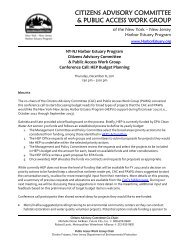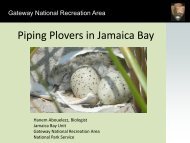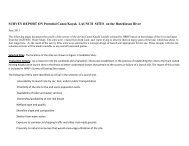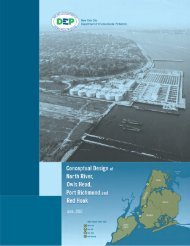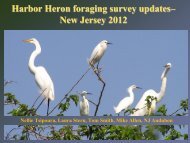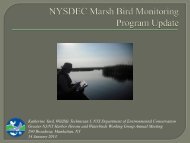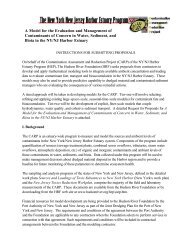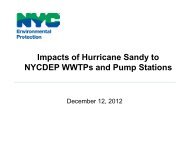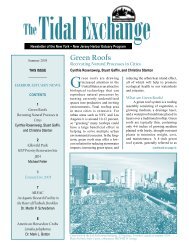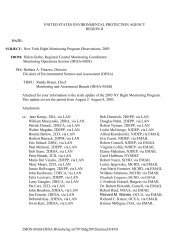Hudson Raritan Estuary Comprehensive Restoration Plan
Hudson Raritan Estuary Comprehensive Restoration Plan
Hudson Raritan Estuary Comprehensive Restoration Plan
Create successful ePaper yourself
Turn your PDF publications into a flip-book with our unique Google optimized e-Paper software.
The Evolving Vision of a World Class Harbor <strong>Estuary</strong>Harbor DeepeningProject to -50 Ft.Drift RemovalDredged MaterialManagementChannel Maintenance<strong>Comprehensive</strong> PortImprovement <strong>Plan</strong>Green PortImprovementsHarborOperationsCommitteeBeneficial Useof DredgedMaterial<strong>Comprehensive</strong>Waterfront<strong>Plan</strong>ning<strong>Hudson</strong>-<strong>Raritan</strong> <strong>Estuary</strong><strong>Comprehensive</strong> <strong>Plan</strong>Liberty State Park<strong>Plan</strong>ning forSea LevelRiseLower Passaic RiverNJ MeadowlandsHarbor <strong>Estuary</strong> ProgramJamaica BayBronxRiverStorm Preparedness<strong>Plan</strong>ningStorm/Flood RiskManagement ProjectsHurricaneEvacuation <strong>Plan</strong>
HRE <strong>Plan</strong>ningRegionsLower<strong>Hudson</strong>RiverNewark Bay, PassaicRiver, HackensackRiverHarlem River,East River,Western LongIsland SoundArthur Kill/Kill Van KullUpperBayJamaicaBayLower<strong>Raritan</strong>RiverLowerBay
What are the Problems in the HRE?• Degraded and contaminated sediments– Human health and ecological risks– Costly dredged material management• Lost and degraded habitat– 80% wetlands are gone– Oyster reefs and eelgrass have disappeared• Poor water quality• Impediments to fish passage• Minimal and dilapidated public access
What are the Problems in the Harlem River /East River / Western Long Island Sound?• IndustrialDischarge• Urban Runoff• HardenedShorelines• Loss of NaturalHabitats
Ongoing Ecosystem <strong>Restoration</strong> in HREHEP SITESHarbor <strong>Estuary</strong> Program/HRE Nominated SitesSee Handout
Ongoing Ecosystem <strong>Restoration</strong> in the UpperBay <strong>Plan</strong>ning RegionLong Island Sound StudySave the Sound, NOAA, USEPA, USFWS,CTDEP, NYSDEC, NYCDEPBronx River <strong>Restoration</strong>USACE, NYCDEP, Westchester County Dept.of <strong>Plan</strong>ningFlushing Bay and Creek <strong>Restoration</strong>StudyUSACE, NYCDEP, PANYNJHarbor Herons ProjectNYC AudubonSoundview ParkUSACE, NYCP&R, NYCDEP
Target Ecosystem CharacteristicsTECsIllustrate:[What][Where][How Much][By When]11 CRP Goal: Create and Restore a mosaic of habitats within a humandominatedlandscape
The CRP includes…• What are we trying to Restore?– Regional <strong>Restoration</strong> Goals/TECs• Where can we restore?<strong>Restoration</strong> Opportunities for each TEC– Existing HEP-nominated sites– Geographic Information System• <strong>Plan</strong>ning Considerations– Conceptual designs and costs– Technical, legal, regulatory constraints, data gaps• Implementation strategies– Potential sponsors and possible fundingmechanisms• Performance measures of progress and success
Eelgrass Bed <strong>Restoration</strong> Opportunities
Coastal Wetland TEC Opportunities
Islands for Waterbirds <strong>Restoration</strong>Opportunities
Oyster Reef <strong>Restoration</strong> Opportunities
Enclosed and Confined Waters ReductionOpportunitiesNote: This figure shows only predicted surface contamination from the Contamination Reduction and Assessment Program (CARP). Legacy chemicals buried below 10 cm are not shown.
<strong>Restoration</strong>Opportunities• Coastal Wetlands• Eelgrass Beds• Oyster Reefs• Islands forWaterbirds• Enclosed andConfined Waters
CoastalWetlands• TEC Goal: 1,200 acresby 2015 and 15,200acres by 2050• More than 12,000acres available for<strong>Restoration</strong> and14,000 acres forCreation
Oyster Reefs• TEC Goal: 500 acresby 2015 and 5,000acres by 2050• Potentially 50,000acres could besuitable
Eelgrass Beds• TEC Goal: One testbed in each <strong>Plan</strong>ningRegion by 2015 andthree establishedbeds by 2050
Islands forWaterbirds• TEC Goal: Enhanceone island in each ofthe main islandgroups by 2015 andall islands by 2050
Policy ConsiderationsChallenges to Implementation….• Placement of fill in Open Waters• Habitat Trade-off / Exchange• Attractive Nuisance– Sediment Contamination– Oyster Reef Policies• Existing protected in-water Structures• Streamlined and Flexible Permitting Process• FundingAlign agency policies and programs to encourage andpromote restoration
Significant Challenge: FundingPotential Costs for Selected TECsTECUnit of<strong>Restoration</strong>Low($/unit)Median($/unit)High($/unit)CoastalWetlandsOysterHabitatAcres $218,587 $277,009 $713,569Cyd excavated $49 $53 $144Acres $51,457 $52,478 $109,776Cyd shell placed $30 $65 $75Eelgrass Acres $1,080 $16,600 $170,083To Achieve Coastal Wetland Goal:• 1200 acres by 2015: $262 to $856 million• 15,200 acres by 2050: $3.3 to $10.8 billion
CRP Implementation• Federal, State, local and Private FundingSources and Mechanisms– Mitigation– Natural Resource Damages Trustees• HEP <strong>Restoration</strong> Work Group and PolicyCommittee– Strategies for coordination to achieve theTEC goals– Alignment of Agency policies to achieveCRP goalsImplementationusing ExistingAuthorityMitigationNRDANew ProgrammaticAuthorization
Feasibility Study• GOAL: Provide the Opportunity forFederal Cost Sharing for Ecosystem<strong>Restoration</strong> Beyond Existing Authority• Existing USACE Authority:– Continuing Authorities Program• Sections 204/207: Beneficial Use of DredgedMaterial• Section 206: Aquatic Ecosystem <strong>Restoration</strong>• Section 1135: Project Modification• Future USACE Authority:– HRE Ecosystem <strong>Restoration</strong> Program
Oyster <strong>Restoration</strong> Research Program21 September 2010Tasks for Feasibility• Evaluation of CRP Sites/Projects Harbor-wide and withineach <strong>Plan</strong>ning Region– Analysis of ecological benefits and costs• Identification of New <strong>Restoration</strong> Opportunities• Develop Implementation strategies• Further State of the Science foreach TEC through detailedinvestigations for oysters,waterbirds, etc.
Oyster <strong>Restoration</strong> Research PartnershipThe Army Corps-NY District/Port Authority of NewYork & New Jersey and Partners (<strong>Hudson</strong> RiverFoundation, NY/NJ Baykeeper, Harbor School, Univ.of New Hampshire, NYCDEP, and others) initiatedconstruction of Oyster Reef Pilots within the NY/NJHarbor <strong>Estuary</strong>. The data collected from this effortwill advance the state of the science for the oysterreef Target outlined in the HRE <strong>Comprehensive</strong><strong>Restoration</strong> <strong>Plan</strong> as part of the HRE Ecosystem<strong>Restoration</strong> Feasibility Study.Oyster Reef Locations9 tons of shell placed atop rubbleOyster spat on shell will beplaced on the reef end ofOctober followed by long-termmonitoring by our Partners23 tons of rubble placed as reef foundation
Oyster <strong>Restoration</strong> Research Project(ORRP)• 6 reef sites: Staten Island, Hastings, Governors Island,Soundview (Bronx River), Jamaica Bay, Bay Ridge Flats• Approximately 15 feet by 30 feet are designed to mimicnatural reefs as much as possible.Photo by: USACE
Status of Evaluation of CRPOpportunities• Total Sites: 320• Updated Via InternetSearch: 260• Sites with Conceptual<strong>Plan</strong>s: 101• Sites with digitizedConceptual <strong>Plan</strong>s: 91• Each <strong>Restoration</strong> Opportunity will bevalidated by Partners/Nominators
What Can You Do?• Identify New <strong>Restoration</strong> Sites andProjects– www.OasisNYC.net• Identify Local Master <strong>Plan</strong>s• Partner with the USACE on <strong>Restoration</strong>Projects• Spread the Word
Coordination with Ongoing Projects
Soundview Park, Bronx, New YorkEcosystem <strong>Restoration</strong> StudyLocal Sponsor: NYC Parks & Recreation
Soundview Park Overview
Soundview Park – Study Area
Soundview Embayment Looking North
Soundview Park -Existing EmbaymentConditions
Soundview Park- Remnant Marsh
Soundview Park - Berm
Soundview - Upland
OverlookApproximately 6 .7 acres of grasses,trees, and ball fieldsBuffer areaplantingsApproximately 3.7 acres ofmarsh plantingsEast RiverSoundview Park Conceptual <strong>Plan</strong>
Questions?For More Information or to Comment on the HRE Ecosystem <strong>Restoration</strong> Study :Email: HRE-PLAN-Comments@usace.army.milWebsite: WWW.Watersweshare.orgLisa BaronChief, Harbor Programs Branch917-790-8306Lisa.a.baron@usace.army.milPeter WepplerChief, Coastal Ecosystem Section917-790-8634Peter.m.weppler@usace.army.mil


